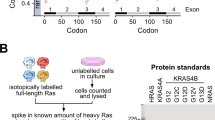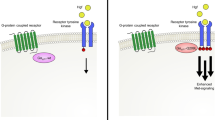Abstract
RAS genes are mutated in approximately 30% of all human cancers. Interestingly, there exists a strong bias in favor of mutation of only one of the three major RAS genes in tumors of different cellular origins. NRAS mutations occur in approximately 20% of human melanomas, whereas HRAS and KRAS mutations are rare in this disease. To define the mechanism(s) responsible for this preference in melanocytes, we compared the transformation efficiencies of mutant NRAS and KRAS in immortal, non-transformed Ink4a/Arf-deficient melanocytes. NRAS mutation leads to increased cellular proliferation and is potently tumorigenic. In contrast, KRAS mutation does not enhance melanocyte proliferation and is only weakly tumorigenic on its own. Although both NRAS and KRAS activate mitogen-activated protein kinase signaling, only NRAS enhances MYC activity in these cells. Our data suggest that the activity of specific RAS isoforms is context-dependent and provide a possible explanation for the prevalence of NRAS mutations in melanoma. In addition, understanding this mechanism will have important implications for cancer therapies targeting RAS pathways.
This is a preview of subscription content, access via your institution
Access options
Subscribe to this journal
Receive 50 print issues and online access
$259.00 per year
only $5.18 per issue
Buy this article
- Purchase on Springer Link
- Instant access to full article PDF
Prices may be subject to local taxes which are calculated during checkout







Similar content being viewed by others
Accession codes
References
Ackermann J, Frutschi M, Kaloulis K, McKee T, Trumpp A, Beermann F . (2005). Metastasizing melanoma formation caused by expression of activated N-RasQ61K on an INK4a-deficient background. Cancer Res 65: 4005–4011.
Aroca P, Urabe K, Kobayashi T, Tsukamoto K, Hearing VJ . (1993). Melanin biosynthesis patterns following hormonal stimulation. J Biol Chem 268: 25650–25655.
Bennett DC, Cooper PJ, Hart IR . (1987). A line of non-tumorigenic mouse melanocytes, syngeneic with the B16 melanoma and requiring a tumour promoter for growth. Int J Cancer 39: 414–418.
Castellano M, Parmiani G . (1999). Genes involved in melanoma: an overview of INK4a and other loci. Melanoma Res 9: 421–432.
Chin L, Garraway LA, Fisher DE . (2006). Malignant melanoma: genetics and therapeutics in the genomic era. Genes Dev 20: 2149–2182.
Chin L, Pomerantz J, Polsky D, Jacobson M, Cohen C, Cordon-Cardo C et al. (1997). Cooperative effects of INK4a and ras in melanoma susceptibility in vivo. Genes Dev 11: 2822–2834.
Davies H, Bignell GR, Cox C, Stephens P, Edkins S, Clegg S et al. (2002). Mutations of the BRAF gene in human cancer. Nature 417: 949–954.
Edgar R, Domrachev M, Lash AE . (2002). Gene Expression Omnibus: NCBI gene expression and hybridization array data repository. Nucleic Acids Res 30: 207–210.
Esteban LM, Vicario-Abejon C, Fernandez-Salguero P, Fernandez-Medarde A, Swaminathan N, Yienger K et al. (2001). Targeted genomic disruption of H-ras and N-ras, individually or in combination, reveals the dispensability of both loci for mouse growth and development. Mol Cell Biol 21: 1444–1452.
Giehl K . (2005). Oncogenic Ras in tumour progression and metastasis. Biol Chem 386: 193–205.
Goel VK, Lazar AJ, Warneke CL, Redston MS, Haluska FG . (2006). Examination of mutations in BRAF, NRAS, and PTEN in primary cutaneous melanoma. J Invest Dermatol 126: 154–160.
Gregory MA, Qi Y, Hann SR . (2003). Phosphorylation by glycogen synthase kinase-3 controls c-myc proteolysis and subnuclear localization. J Biol Chem 278: 51606–51612.
Henriksson M, Bakardjiev A, Klein G, Luscher B . (1993). Phosphorylation sites mapping in the N-terminal domain of c-myc modulate its transforming potential. Oncogene 8: 3199–3209.
Holmen SL, Williams BO . (2005). Essential role for Ras signaling in glioblastoma maintenance. Cancer Res 65: 8250–8255.
Kamemura K, Hayes BK, Comer FI, Hart GW . (2002). Dynamic interplay between O-glycosylation and O-phosphorylation of nucleocytoplasmic proteins: alternative glycosylation/phosphorylation of THR-58, a known mutational hot spot of c-Myc in lymphomas, is regulated by mitogens. J Biol Chem 277: 19229–19235.
Kamijo T, Zindy F, Roussel MF, Quelle DE, Downing JR, Ashmun RA et al. (1997). Tumor suppression at the mouse INK4a locus mediated by the alternative reading frame product p19ARF. Cell 91: 649–659.
Kim K, Lindstrom MJ, Gould MN . (2002). Regions of H- and K-ras that provide organ specificity/potency in mammary cancer induction. Cancer Res 62: 1241–1245.
Klein PS, Melton DA . (1996). A molecular mechanism for the effect of lithium on development. Proc Natl Acad Sci USA 93: 8455–8459.
Koera K, Nakamura K, Nakao K, Miyoshi J, Toyoshima K, Hatta T et al. (1997). K-ras is essential for the development of the mouse embryo. Oncogene 15: 1151–1159.
Land H, Parada LF, Weinberg RA . (1983). Tumorigenic conversion of primary embryo fibroblasts requires at least two cooperating oncogenes. Nature 304: 596–602.
Maher J, Baker DA, Manning M, Dibb NJ, Roberts IA . (1995). Evidence for cell-specific differences in transformation by N-, H- and K-ras. Oncogene 11: 1639–1647.
Prior IA, Hancock JF . (2001). Compartmentalization of Ras proteins. J Cell Sci 114: 1603–1608.
Scherf U, Ross DT, Waltham M, Smith LH, Lee JK, Tanabe L et al. (2000). A gene expression database for the molecular pharmacology of cancer. Nat Genet 24: 236–244.
Sears RC . (2004). The life cycle of C-myc: from synthesis to degradation. Cell Cycle 3: 1133–1137.
Serrano M, Lee H, Chin L, Cordon-Cardo C, Beach D, DePinho RA . (1996). Role of the INK4a locus in tumor suppression and cell mortality. Cell 85: 27–37.
Sinn E, Muller W, Pattengale P, Tepler I, Wallace R, Leder P . (1987). Coexpression of MMTV/v-Ha-ras and MMTV/c-myc genes in transgenic mice: synergistic action of oncogenes in vivo. Cell 49: 465–475.
Solit DB, Garraway LA, Pratilas CA, Sawai A, Getz G, Basso A et al. (2006). BRAF mutation predicts sensitivity to MEK inhibition. Nature 439: 358–362.
Sviderskaya EV, Hill SP, Evans-Whipp TJ, Chin L, Orlow SJ, Easty DJ et al. (2002). p16(Ink4a) in melanocyte senescence and differentiation. J Natl Cancer Inst 94: 446–454.
Umanoff H, Edelmann W, Pellicer A, Kucherlapati R . (1995). The murine N-ras gene is not essential for growth and development. Proc Natl Acad Sci USA 92: 1709–1713.
Vogelstein B, Fearon ER, Hamilton SR, Kern SE, Preisinger AC, Leppert M et al. (1988). Genetic alterations during colorectal-tumor development. N Engl J Med 319: 525–532.
Yan J, Roy S, Apolloni A, Lane A, Hancock JF . (1998). Ras isoforms vary in their ability to activate Raf-1 and phosphoinositide 3-kinase. J Biol Chem 273: 24052–24056.
Acknowledgements
We thank Dr Vincent Hearing for providing the anti-PEP7 antibody, Dr Stephen Hughes for the RCASBP(M2C)797-8 virus and Dr Brian Lewis for the RCASBP(A)MYC virus. We thank Bryn Eagleson, Elissa Boguslawski, Dawna Dylewski and the vivarium staff for assistance with the animal experiments. We thank Dr Kyle Furge and Karl Dykema (Laboratory of Computational Biology) for technical assistance and helpful comments. We also thank David Nadziejka for critical review of the manuscript. This work was supported by funds from the Melanoma Research Foundation, the James A Schlipmann Melanoma Cancer Foundation and the Van Andel Research Institute. Lastly, the authors wish to dedicate this work to the memory of Dr Han-Mo Koo, who made significant contributions to the scientific community and especially to cancer research.
Author information
Authors and Affiliations
Corresponding author
Additional information
Supplementary Information accompanies the paper on the Oncogene website (http://www.nature.com/onc).
Supplementary information
Rights and permissions
About this article
Cite this article
Whitwam, T., VanBrocklin, M., Russo, M. et al. Differential oncogenic potential of activated RAS isoforms in melanocytes. Oncogene 26, 4563–4570 (2007). https://doi.org/10.1038/sj.onc.1210239
Received:
Revised:
Accepted:
Published:
Issue Date:
DOI: https://doi.org/10.1038/sj.onc.1210239
Keywords
This article is cited by
-
NRAS expression is associated with prognosis and tumor immune microenvironment in lung adenocarcinoma
Journal of Cancer Research and Clinical Oncology (2022)
-
KRAS, NRAS and BRAF mutations in colorectal cancer and melanoma
Medical Oncology (2017)
-
Cystathionase mediates senescence evasion in melanocytes and melanoma cells
Oncogene (2014)
-
NRAS mutant melanoma: biological behavior and future strategies for therapeutic management
Oncogene (2013)
-
Activated Mutant NRasQ61K Drives Aberrant Melanocyte Signaling, Survival, and Invasiveness via a Rac1-Dependent Mechanism
Journal of Investigative Dermatology (2012)



